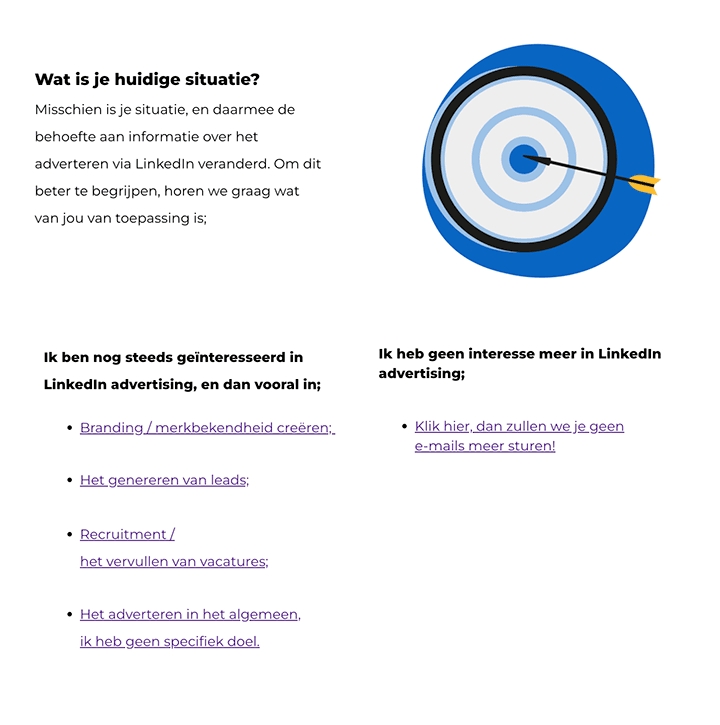What is the difference between a lead and a prospect?
A lead, in other words: a potential customer on a journey. Lead generation is crucial for the success and growth of your organization. Generating leads is usually the first step in the sales process. But who are you and what do you do as a lead?
As a lead, you go through two different phases, each associated with its own definition:Marketing Qualified Leads (MQL)
Sales Qualified Leads (SQL)
What is a marketing qualified lead?
A marketing qualified lead (MQL) is a website visitor who demonstrates behavior on your website indicating that he or she is interested in potentially becoming a customer. A visitor to whom the term MQL is assigned has triggered a conversion on the website. This could be, for example, filling out a web form, downloading content, signing up for a newsletter, or another type of conversion. The information left at the moment of conversion is all the data you have about this MQL. You do not know why he or she has shown interest, nor do you know if or when a person will make a purchase. You likely only have a name and an email address. But even with this information, you can move a visitor further down the funnel. On to the SQL!
Sidenote: Once a lead leaves their information, you can track website behavior in the future with marketing automation.
Lead scoring
By assigning a lead score to each type of conversion/interaction from the visitor, the marketing and sales team can precisely see where the visitor is in the customer journey. Based on this information, you can tailor the content and resources used to move the visitor further down the funnel according to the lead's status.
Lead scoring is the process of assigning points to the actions that leads take. For example, opening a follow-up email, clicking on a link in the email, or visiting a specific page on your website. Lead scoring allows you to quickly identify which leads have the highest potential to become prospects and customers. This optimizes the sales process, as the sales department does not need to determine whether the lead is "warm" enough.
The marketing team can keep the lead "warm" until they are actually ready to make a purchase. This is called lead nurturing.
The journey from MQL to SQL
An MQL does not automatically become an SQL. It is your task to trigger and motivate this visitor to take further steps. Through lead nurturing, you introduce leads to your organization via an email flow. In this process, you learn more about each lead, allowing you to serve them better. The marketing automation platform enables you to see exactly which emails and links are opened. As a result, the content can be made increasingly specific. You engage the leads with relevant information about the topics in which they previously showed specific interest. In this way, you continue to follow up with and warm up the leads until they are ready for the next step towards making a purchase.
Once enough information has been gathered about the interests and needs of the lead, and the lead score is high enough, you can forward the lead to the sales department. The lead is then ready for the next step. Now it is the sales team's turn. They are now responsible for reaching out to the leads regarding the product or service in which interest has been shown. At this point, a marketing qualified lead becomes a sales qualified lead.
A sales qualified lead (SQL) is a lead that distinguishes itself from other leads based on certain actions. Unlike a marketing qualified lead (MQL), an SQL is ready to be followed up by the sales team.
What is a prospect?
A prospect is a potential customer who has shown interest in your products or services by responding to your follow-up. Thus, they have the potential to develop into a customer.
Now that the process of leads and the phases have been clearly mapped out, we have arrived at the prospect. When is someone considered a prospect? The main difference between a lead and a prospect is that a prospect has moved beyond one-way communication. A lead becomes a prospect when there has been mutual communication. For example, a response to an email or to the sales team. Based on this communication, you can suggest that the lead has the intention to genuinely purchase a product or service from you. When that intention becomes clear, the lead becomes a prospect.
Can a lead become a prospect?
Now that the definitions are clear, it is evident that the sales process differs by type. A lead is not in the same phase as a prospect. Therefore, you need to adjust your marketing activities for each phase and accurately map out where a person is in the funnel.
To begin with, a lead must meet your criteria. You know better than anyone when someone is interesting enough to be included in your company's narrative. Do they fit your company? Do the leads come from the desired industry? Do they hold the right position that makes them worth following up with and contacting? These are questions you need to ask yourself to determine whether the lead should be included in the funnel or not. If they do not meet your criteria, you can reach out endlessly, but they are essentially not suitable for purchasing your services/products. Is the lead interesting enough? Then the follow-up can begin!
Every lead has a number of challenges/pain points that make them interested in a company. You can capitalize on this by creating value, so that the lead engages with your content. A response can be a click on a link or a reply during a contact moment with the sales team. This is an example of how a lead can quickly respond to an email. This clarifies the situation, allowing you to approach the lead even more specifically.

In short, with the help of an email follow-up, you aim to determine the challenge and situation of the lead. You explain how your product/service can help. If the lead then responds to an email, the lead becomes a prospect, and it becomes a challenge for sales to close the deal.
From prospect to customer
When the lead has sought out interaction themselves and is now being qualified as a prospect, all alarm bells should go off for the sales team. The person is now very close to making a purchase. The sales team must take over by personally contacting the leads and prospects.
Do you realize that not every lead automatically becomes a prospect, and that a person sometimes does not seek any interaction at all? This does not mean that this person is not worth approaching. With these leads, the need is often somewhat lower. It is wise to give them a bit more time and to provide them with more inspiring content in the email follow-up.
A marketing qualified lead has only briefly identified themselves as someone who wants more information. Beyond that, you actually know nothing about them. Through lead scoring in marketing automation, you can determine when the MQL becomes a SQL and a prospect.
It is important for the sales team to understand the prospect's needs so that they can create a tailored proposal.
Lead generation
Now that you know what leads and prospects are, and we have mapped out the journey of the potential customer, we have arrived at the most important first step: Lead generation. Interesting leads must first be gathered before you can follow up with content. But how do you generate the desired number of leads? Proper lead management is crucial for shaping the sales funnel further and generating revenue for your business.
It is important to determine the right strategy when acquiring leads and prospects. Of course, you want to proactively follow up with leads and prospects, but a good balance is necessary. That is why it is essential to ensure that you are approaching the right person, the decision-maker. This way, you also know at what level you can engage with them. In addition to the level and the person, there must be a clear strategy in place for the content and approach. What do you want to tell the potential customer, and how do you want to convince them to choose you?
The foundation of good lead generation is providing value. Without value that is interesting to the target audience, you will not generate interest. Next comes the target audience. Without a clear description of the target audience, you won't get the desired leads. Are you sure you have fully mapped out the target audience?
Where is the target audience located, and what message do you want to convey to them? Choose the right channels and direct your message specifically at your target audience. Now, motivation and interest are needed to engage with your company. What would be very interesting for your target audience that would prompt them to leave their information? If they are enthusiastic enough, they will provide details that are of great value to you for continuing lead generation. Now it is time to keep the leads warm and prepare them for the next conversion so that they ultimately become a prospect. And eventually, of course, a satisfied customer.
Automate this process with marketing automation
This entire process can be automated by implementing marketing automation. SharpSpring is the number 1 marketing automation software in the Netherlands. Schurq. was the first provider of this software in the Netherlands and has since been appointed as a partner.
SharpSpring Marketing Automation guides you through the customer journey of your leads. This way, you know exactly how to deliver the right message at the right time to the right person. This stimulates conversion and the transformation of leads into customers. You can see exactly what your leads are doing on your website and where they are clicking. You can assign points to your leads based on the actions they take. This allows you to see how a lead becomes increasingly warm. SharpSpring automates your emails and offers dynamic content, making communication more personal.
We hope that after reading this article, you clearly understand the difference between a lead and a prospect. The most important thing is that you recognize that each is in a different phase of the sales process. Therefore, a specified approach and strategy is necessary. However, with the right approach, strategy, and the help of marketing automation, you will generate more leads that you can convert into prospects in no time.
Want to know more about lead generation, sales funnels, or are you interested in Marketing Automation?

